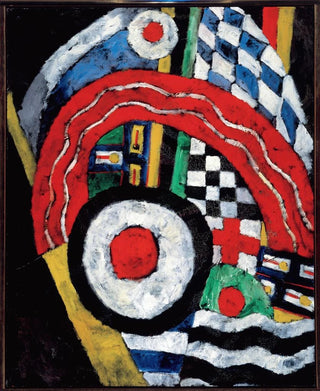Art print | Painting No. 46 - Marsden Hartley


View from behind

Frame (optional)
The "Art print n° 46" by Marsden Hartley is a piece that transcends mere visual representation to immerse the viewer in a universe where color and form engage in dialogue with rare intensity. This iconic work, created amidst the tumultuous context of the 1910s, stands out for its bold approach and exploration of emotions through abstraction. Hartley, a major figure of American modernism, manages to capture the very essence of nature and the human spirit in a unique pictorial language. Contemplating this piece, one is quickly transported to a world where each brushstroke seems to tell a story, where every shade of color evokes a deep feeling.
Style and uniqueness of the work
Hartley's style is characterized by a daring use of color and geometric shapes that blend into a fascinating harmony. In "Art print n° 46," the artist plays with vibrant hues that create a dynamic and lively atmosphere. The shapes, often abstract, seem to dance across the canvas, evoking both movement and stability. Hartley also uses motifs reminiscent of nature, while deforming them to reinvent them in a personal visual language. This work thus perfectly reflects the artist's quest to express complex emotions and inner experiences through a medium that, at first glance, might seem meaningless. The depth of this piece lies in its ability to establish an emotional connection with the viewer, inviting introspective reflection.
The artist and his influence
Marsden Hartley, born in 1877, is often regarded as one of the pioneers of modern art in the United States. Influenced by his travels in Europe and by iconic figures such as Wassily Kandinsky and Henri Matisse, Hartley developed a style that is uniquely his own, combining abstraction and figurative elements. His work is marked by an incessant search for authenticity and inner truth, which allowed him to touch on universal themes such as love, solitude, and spirituality. Hartley also played a crucial role in promoting American art on the international stage, opening

Matte finish

View from behind

Frame (optional)
The "Art print n° 46" by Marsden Hartley is a piece that transcends mere visual representation to immerse the viewer in a universe where color and form engage in dialogue with rare intensity. This iconic work, created amidst the tumultuous context of the 1910s, stands out for its bold approach and exploration of emotions through abstraction. Hartley, a major figure of American modernism, manages to capture the very essence of nature and the human spirit in a unique pictorial language. Contemplating this piece, one is quickly transported to a world where each brushstroke seems to tell a story, where every shade of color evokes a deep feeling.
Style and uniqueness of the work
Hartley's style is characterized by a daring use of color and geometric shapes that blend into a fascinating harmony. In "Art print n° 46," the artist plays with vibrant hues that create a dynamic and lively atmosphere. The shapes, often abstract, seem to dance across the canvas, evoking both movement and stability. Hartley also uses motifs reminiscent of nature, while deforming them to reinvent them in a personal visual language. This work thus perfectly reflects the artist's quest to express complex emotions and inner experiences through a medium that, at first glance, might seem meaningless. The depth of this piece lies in its ability to establish an emotional connection with the viewer, inviting introspective reflection.
The artist and his influence
Marsden Hartley, born in 1877, is often regarded as one of the pioneers of modern art in the United States. Influenced by his travels in Europe and by iconic figures such as Wassily Kandinsky and Henri Matisse, Hartley developed a style that is uniquely his own, combining abstraction and figurative elements. His work is marked by an incessant search for authenticity and inner truth, which allowed him to touch on universal themes such as love, solitude, and spirituality. Hartley also played a crucial role in promoting American art on the international stage, opening






